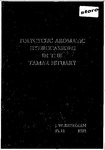POLYCYCLIC AROMATIC HYDROCARBONS IN THE TAMAR ESTUARY
| dc.contributor.author | Readman, James William | |
| dc.contributor.other | School of Geography, Earth and Environmental Sciences | en_US |
| dc.date.accessioned | 2012-08-03T10:42:04Z | |
| dc.date.available | 2012-08-03T10:42:04Z | |
| dc.date.issued | 1982 | |
| dc.identifier | Not available | en_US |
| dc.identifier.uri | http://hdl.handle.net/10026.1/1107 | |
| dc.description.abstract |
The high particulate association of PAH in aquatic systems has often been attributed to the hydrophobic nature of the compounds leading to adsorption. Results presented i n this thesis strongly suggest that a significant proportion of PAH in the Tamar are particle-incorporated and unavailable for dynamic partition and physical, chemical and biological fates. The generally uniform PAH composition identified throughout the estuary is highly indicative of a combustion or road and urban runoff source. PAH distrubution in a dated Tamar Estuary sediment core showed an exponential decrease with depth and identified dramatic increases in PAH flux during the last 20 years. This suggests an association with motor vehicles probably via road runoff. No significant trends of change in PAH composition with depth were apparent, indicating unifoinnlty of source and the unimportance of PAH degradation mechanisms in the anoxic-sediment. Ibrylene displayed an anomalous distribution that could be attributed to its biogenic origin. A survey of PAH distribution in the estuarine water column identified two areas exhibiting high concentrations. The first was observed at the turbidity maximum at the head of the estuary (by virtue of particle-associated PAH) and the second as a result of an emission in the urban region during the, sampling period. A similar distribution was identified in the estuarine surface sediments which are shown to act as a sink for both riverine and urban PAH. Suspended particulates in the water column, in general, contain similar levels and compositionally reflect the higher molecular weight PAH (M>200) in the sediments. Ihis underlines the importance of particulate transport and indicates that degradation of these PAH in the water column, is of minor significance, with sediment incorporation as their primary fate. Lower MW PAH (MW<200)were enriched in soluble forms in the water column. Microbial heterotrophic degradation and volatilisation are proposed as important environmental fates of these low MW compounds. | en_US |
| dc.description.sponsorship | The Institute for Marine Environmental Research | en_US |
| dc.language.iso | en | en_US |
| dc.publisher | University of Plymouth | en_US |
| dc.title | POLYCYCLIC AROMATIC HYDROCARBONS IN THE TAMAR ESTUARY | en_US |
| dc.type | Thesis | |
| dc.identifier.doi | http://dx.doi.org/10.24382/1541 | |
| dc.identifier.doi | http://dx.doi.org/10.24382/1541 |
Files in this item
This item appears in the following Collection(s)
-
01 Research Theses Main Collection
Research Theses Main


